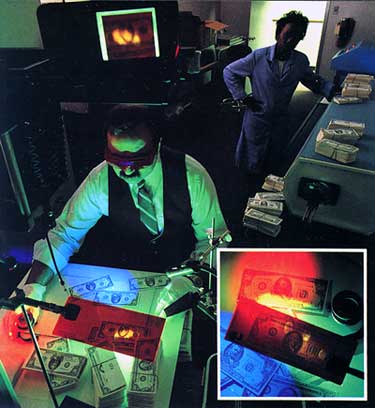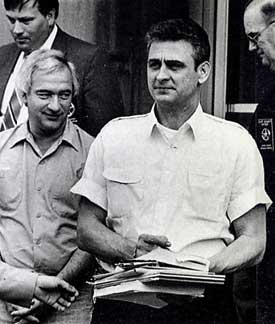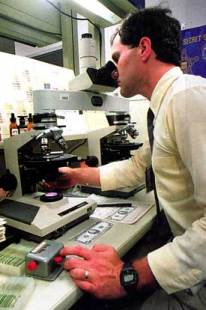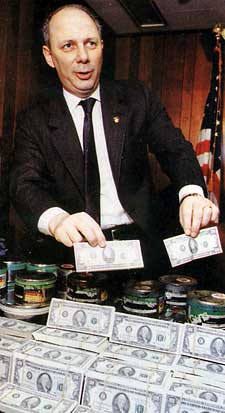Long Days on the Fake Money Trail
By Stephen Brookes • Insight Magazine • November 27, 1989
___________________________________________________________________________________
When city sanitation workers emptied a trash bin in the Bronx one July morning last year, they found more than gum wrappers, empty bottles and tossed-out junk mail. Mixed in with the usual urban debris was a sizable fortune: $18 million in crisp new bills, as fresh and clean as if they had just come off the printing press. In fact, as the garbage men soon discovered, they had. The bills had been jettisoned by an international counterfeiting ring that had been operating out of New York for months. The ring had become convinced that federal authorities were onto them.
At the Secret Service Forensics Lab B. Cabe By trying to get rid of the evidence, the counterfeiters put investigators onto a trail that led ultimately to the arrest of some 85 people around the country, including suspected ringleader Francisco Scocozza, a 55-year-old used car dealer from Uruguay. As millions in phony bills surfaced, the ring was revealed to be the biggest counterfeiting operation ever broken up by U.S. authorities.
"When we debriefed these people," says Richard Ward, head of the Secret Service's New York office, "it appeared they had printed about $100 million over about two years."
Counterfeiting has become a huge business, as the Scocozza case shows. The Secret Service, the federal agency charged with finding counterfeiters and shutting them down, seized $88 million in fake U.S. currency during fiscal 1989 and about $122 million the year before. That's a lot of bad paper, but it's only a fraction of the $1 billion or so that authorities estimate is printed every year in the United States. Add to that another $1 billion in greenbacks printed overseas.
The massive size and international scope of the newly uncovered operations have investigators worried. "There's been a huge increase," says agent Ward. "While they used to print $2 or $3 million a few years ago, now they're printing $30 or $40 million."
As recently as the mid-1980s, busting a $300,000 operation -- or "plant,” as the Secret Service calls it -- would have been a big deal. But the spectacular seizures that have become almost commonplace suggest that the counterfeit game is changing and that new players are getting involved. "The dramatic rise in amounts being seized signals to us that the money is going to be used in a significant, major enterprise," says agent Jane Vezeris in Washington. "And what comes to our minds is drugs.”
Evidence for a connection is mounting. A growing number of drug busts are leading to counterfeiting operations. Secret Service agents in Los Angeles, for example, arrested a 65-year-old Argentine named Nicolas C. Tano in September, following a two-week investigation by the Drug Enforcement Administration and local authorities. When they grabbed him, Tano was literally working the printing press for a substantial counterfeiting operation: Agents seized close to $1 million in fake tens and twenties, bills commonly used in drug deals.
And while no direct ties to drugs have been made in the huge Scocozza case in New York, "there was talk among the defendants that this money was part of drug deals, because of the vast amounts of money needed in these deals," says Ward.
Fake money appeals to big drug dealers for a number of reasons. Most of their business is in cash, so they can palm phony bills off on their suppliers and employees and pocket the difference. By purchasing large amounts of counterfeit at cut-rate prices (usually from 20 to 30 percent of face value, depending on quality) or setting up a plant in a safe haven and manufacturing their own cash, they can multiply their drug profits several times over.
Owning a money factory, in fact, is becoming de rigueur among the drug cartels. “A lot of this money is manufactured in South America, specifically Colombia, and we find it's tied hand in glove with the drug traffic in South Florida," says Jack E. Kippenberger, head of the Secret Service's Miami office. "Sometimes they'll try to rip each other off with it. And if one drug dealer pays the other with counterfeit money, what's the other guy going to do? Go to the police?"
Counterfeiting, of course, isn’t limited to drug dealers alone. While huge, long term rings like Scocozza's 85-man operation surface from time to time, most counterfeit operations are tiny by comparison and may exist only a short time. It is a relatively easy business to get into: With a skilled printer and a photographer, and a few people to handle distribution and protection, a counterfeiter can set up a national network producing millions of dollars quickly and cheaply.
A complete home operation with printing press, light table, inks and paper can be had for as little as $10,000, but even that kind of investment is not necessary. A substantial amount of counterfeiting is done by owners or employees of print shops, who can slip in after hours, run off a batch of cash and slip out with no one the wiser.
Counterfeiters run the gamut of sophistication, from the crudest -- who simply cut the comers off large-denomination bills and glue or tape them to $1 notes (known as ‘raising the notes’) -- to rare, no-expense-spared operators with full-fledged intaglio printing facilities.
To print money the way the government does would be a daunting task. The Bureau of Engraving and Printing in Washington uses 65 separate, automated steps to make the familiar greenback. All the plates are engraved by hand. A different person engraves each part, so that no individual knows how to engrave the entire bill. The notes are printed using secret formula inks and a complex combination of the intaglio and typographic processes.
But the average counterfeiter doesn’t bother with anything so elaborate. There is almost no one who actually engraves plates; most prefer to use a relatively simple photomechanical process, offset lithography. It begins by photographing a bill, front and back, on extremely fine-grain film, then touching up the full-size negatives to get a good quality Treasury seal (printed in green on the right side of the face of the note). Faking the seal is the trickiest part of the operation, since the counterfeiter has to ink out or filter away the black overprinting; that makes it almost impossible to get a clear, crisp seal.
Once the counterfeiter has a negative he is happy with, he exposes it onto a photosensitized aluminum plate, mixes up his inks and starts running off bills on an offset press. Once printed, the bills are cut to size and sometimes artificially aged by folding them, dipping them in tea or coffee, or even running them through a washing machine.
A key problem for counterfeiters is finding convincing paper, with the right color and distinctive feel. The paper that real money is printed on is 75 percent cotton and 25 percent linen, with blue and red synthetic threads embedded in it. Only one manufacturer, Crane & Co. Inc. of Dalton, Mass, makes it, and it is illegal to make anything even close. The next best thing is 100 percent rag bond paper, but that’s expensive and attracts attention when purchased in large quantities. And high-quality paper is normally soaked with optical brighteners, giving it a white, unrealistic look.
One way around the paper problem, popular among European counterfeiters, is to bleach the ink off $1 bills, then reprint them as $20, $50 or $100 bills. Well-printed bills on authentic paper can be very difficult for even professionals to detect.
McCoy was nabbed on copying chargesNew color copier technology has created opportunities for the casual counterfeiter. In July, John P. McCoy was convicted in South Carolina on charges that he made $800,000 in U.S. and Canadian currency on a Canon Color Laser Copier. While copier counterfeits account for less than 3 percent of what the Secret Service seizes, some in the agency worry that the numbers may go up. "We're seeing some excellent machine-made notes," says Peter Smoot, an agent in the forensics division. "But they're coming off machines that cost over $50,000. When the price comes down and they become more readily available, then we'll have a problem."
While most rings focus on currency, many will make anything they can get cash for: credit cards, traveler's checks, cashier's checks, even department store gift certificates. Traveler's checks are especially popular. Investigators seized more than $39 million in fake checks in Florida in October 1988, busting a multinational group of Israelis, Americans, Colombians and Cubans that had passed about $40,000 worth of the checks -- described as "very high quality" - in stores along the East Coast.
The profits from counterfeiting are high, but it is a risky business. There is a maximum fine of $5,000 or 15 years or both for each count of manufacturing and passing fake bills, even for the casual counterfeiter who runs off a few bills on a copier machine. "People shouldn't think that copying a couple of notes is just a lark," says Vezeris. "It's a felony, and traditionally the courts have been very tough in their sentencing of counterfeiters."
Despite the risks, new groups enter the field all the time. "When I first started in the mid-'60s, most of our investigations involved the Italian criminal groups," says Ward. "Today you don't see it. Now it's the new immigrant groups: the Dominicans, the Russian émigrés, the Colombians. The Dominicans are one of the big groups right now in counterfeiting. In the last five years we've had at least three or four plants that were Dominican, and we know that there are a couple of plants operating now. We can tell by the new notes coming in."
Counterfeiting is a problem outside the United States as well: Fake greenbacks marked at more than $125 million were seized overseas last year, and 34 percent of the fake bills seized in the United States last year were manufactured abroad. The U.S. dollar is still the currency of choice for foreign counterfeiters, partly because of the difficulty in duplicating the complicated color schemes that other countries use to defend their currencies, but also because it is the most widely used and widely recognized currency in the world.
Whole black market economies in many parts of the world, in fact, run on the dollar -- especially in South America, where the drug trade has spawned a thriving market for dollars. Most of the fake money stays in the black market, but some of it inevitably finds its way to the United States, sometimes brought in from Latin America along traditional drug smuggling routes. "At one time, as much as 25 percent of the money being passed in the United States was being manufactured in that region," says Ward.
Checking fober content at the labAlmost no country is immune to counterfeiters. Mexicans were warned earlier this year not to buy U.S. dollars from strangers, after federal police in Chihuahua state seized $11 million in fake money in February and arrested Newton Van Drunen, now serving time in prison in Ciudad Juarez on counterfeit charges. To the north, a major Canadian operation was shut down in August when Royal Canadian Mounted Police seized more than $1.95 million in fake U.S. $100 bills in Montreal.
A number of European countries have been emerging as sources of high-caliber counterfeiting as well. In April, Italian police seized $23 million in fake $100 bills said to be so good that they fooled FBI agents invited to examine them. A major ring was broken up in West Germany the same month, when authorities arrested a West German and his Israeli accomplice and seized $12 million in counterfeit U.S. currency and enough high quality currency paper to print some 200 million bills. Even the Soviet Union has a problem. According to Interior Ministry figures, 326 cases were uncovered from 1986 to 1988, involving more than 16,000 rubles and $233,000 in U.S. bills.
But Asia may be the world's counterfeit capital. Millions of fake dollars are said to be circulating in the Pacific region, much of it printed in Bangkok, Hong Kong, Malaysia and the Philippines. The $100 bill is widely faked, but other currencies, from the Philippine peso to the Indonesian rupiah, are also being made.
And the stuff is good. “As a rule, the counterfeits we're seeing come out of Asia are of high quality," says Al Joaquin, special agent in charge of the Secret Service's Honolulu office, which oversees Asian operations. “And the Asian rings aren't like the usual two- or three-man operations you see elsewhere. Usually there are several people involved who deal with the distribution and banking channels. They're much more organized than the run-of-the-mill counterfeiter here."
Investigators say that the Philippines is emerging as Asia's new counterfeiting hot spot. A major syndicate making Japanese yen and U. S. dollars in a Manila suburb was broken up in March, but the bust failed to make much of a dent in the flow of dollars coming out of the country. "The big problem we're encountering now is in the Philippines," says Joaquin. “A majority of the Asian counterfeits -- from Thailand, Indonesia and Malaysia, for example -- stay in the region. But a lot of the counterfeit money from Manila is being channeled back into the United States."
Even certain governments are reputed to resort to counterfeiting to get hard currency. U.S. government sources are close-lipped about where, or even whether, the practice takes place. But in May 1988, Kim Chong Min, the president of a North Korean trade company, showed up in South Korea with a strange tale of deception and woe. Kim claimed that he had been sent by his government to Eastern Europe and Zaire to buy $500,000 in counterfeit U.S. dollars but that he had been swindled out of his government-provided funds. Rather than return to a firing squad in Pyongyang, he took a plane to South Korea and asked for asylum.
Radical political groups and terrorists sometimes get involved in counterfeiting as well. Occasionally, they are close to home. White supremacist David Ross Dorr pleaded guilty in March 1987 to counterfeiting conspiracy charges with the Ku Klux Klan in California in an apparent plot to finance a race war. Donal Moyna, believed to be an electronics expert for the outlawed Irish Republican Army, was arrested at New York's La Guardia Airport last February with almost $14,000 in fake money. Before deporting Moyna back to Ireland in June, investigators determined that the money came from an IRA counterfeiting operation busted up by U.S. and Irish authorities last year in Dublin.
Certain Middle Eastern countries are also thought to be sources of fake money, which then makes its way to radical groups. The government of Turkey reported in June that it had seized an undisclosed amount of counterfeit West German, American and Turkish currency that it claimed had been made in Syria and Lebanon, and then smuggled into Turkey by the separatist Kurdish Workers' Party to pay for staff and weapons.
While the Secret Service maintains offices in Rome, Paris, Bangkok and a number of other capitals around the world to fight counterfeiting, its main focus is on the home front. Its 1,950 agents, spread out over 65 field offices, use a variety of investigative techniques, from undercover sting operations to paid tipsters, in order to crack counterfeiting operations.
Ward's haul involved 85 arrests
Sometimes, they just get lucky: New York authorities seized more than $1 million in fake money two years ago, after police found two phony $50 bills on a man who jumped a subway fare gate. But a more reliable source of information is the tip-off from a printing supply house. One Salt Lake City company called the Secret Service last August to report a suspicious purchase of materials commonly used in counterfeiting. Shortly afterward agents arrested James M. Colvin, who later admitted printing up a batch of low-quality $100 bills. (Colvin told investigators that he decided to try his hand after seeing the 1985 movie "To Live and Die in L.A.," which centered on a pyromaniacal counterfeiter. Apparently he wasn’t the only one: "We've had as many as 20 cases where the people involved said they got the idea from that movie," says agent Vezeris.)
There are few giveaways for the really top-notch bills. Most counterfeiters rely on the fact that few people really look at their money, assuming that it is legitimate. "The thing with counterfeit," says Ward, "is that it really doesn't need to be that good to be successfully passed."
Bad paper is often detected only when a victim tries to deposit it in a bank, which is where a counterfeit may get its first careful screening. 'All of our tellers go through a rigorous training program on the detection of counterfeit money," says Boris E. Melnikoff, an officer of First Atlanta Bank in Georgia. "That's not to say that no [fake] money gets into or out of the system. It's not utopia. Depending on the quality of the workmanship, it's possible that currency could go into the system and slip back out. But we keep the losses to a minimum."
When banks find fake bills they send them to the Secret Service's forensic division in Washington, where they are identified and compared with the collection of almost 15,000 different counterfeits on file to see if the bill is from a known batch or a new operation. Each fake bill's federal seal is studied and photographed, the ink is tested for composition and magnetic properties, the paper is examined, and the bills are checked for fingerprints. In some cases, the bills are put under an electron scanning microscope to check paper composition.
There have not been any changes to U.S. currency since 1963, when the words "In God We Trust" were added. But the Treasury Department has been talking for years about weaving a clear polyester thread into the paper that would make fakes made on copier machines easier to detect by leaving a black mark on the copies. Crane & Co. patented a way to add the thread last year, and Treasury is expected to announce that it will start using the new paper and possibly make other design changes fairly soon.
More changes may be in the wind as well. Sen. John F Kerry, a Massachusetts Democrat, has introduced legislation that would require bar codes on new currency to make it easier to trace in counterfeiting and money laundering investigations.
No matter what changes are introduced, investigators predict that counterfeiters will always manage to find a way around them. And once caught, a counterfeiter can be difficult to keep locked up. William "Pops" Kems, 67, a longtime forger with three counterfeiting arrests under his belt, was arrested again last July in Indianapolis. A month later he walked away from the city's detention center by forging a hospital pass. He hasn't been seen since.

